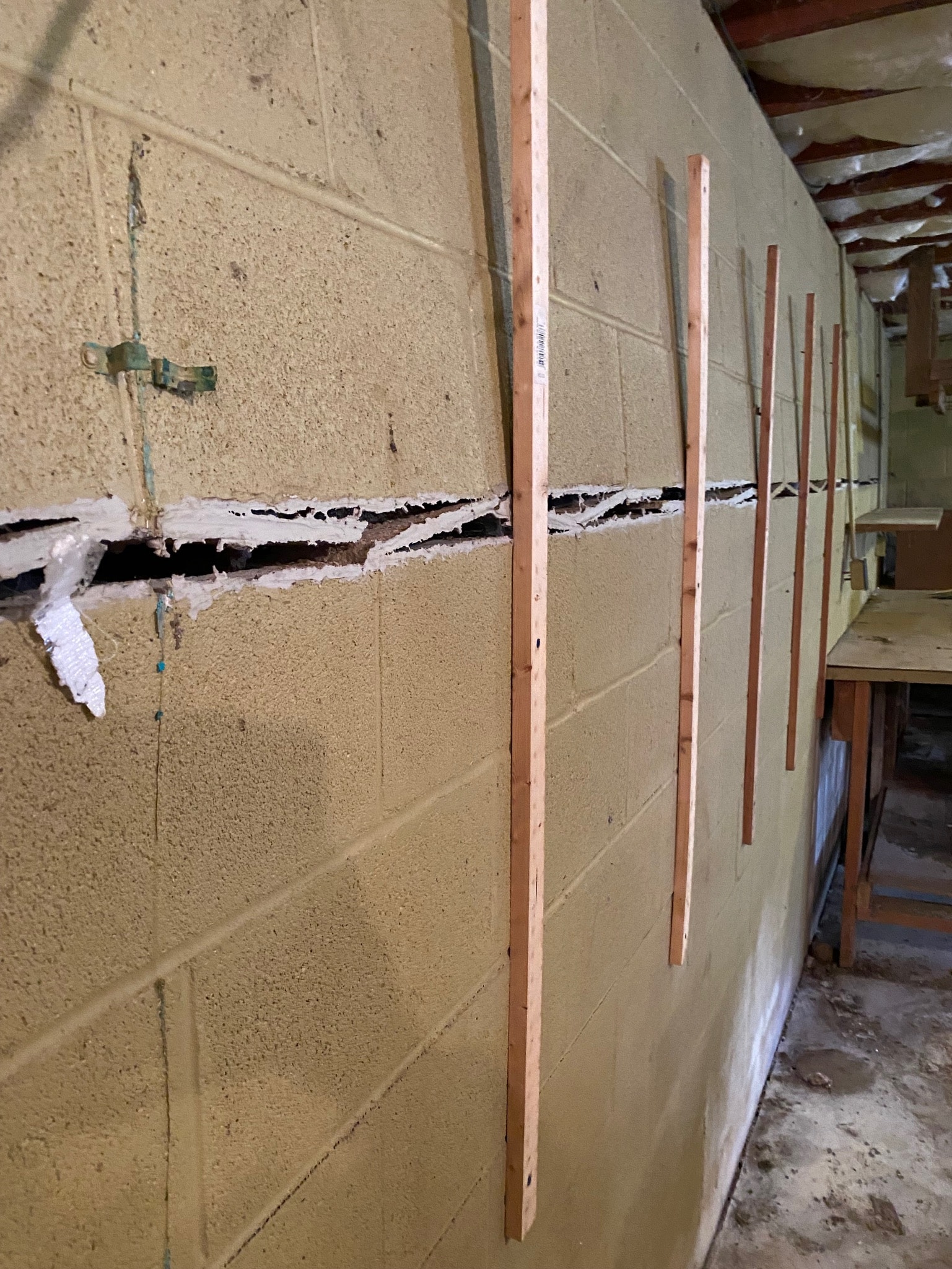
Bowed basement walls are one of the clearest signs of serious structural stress, usually caused by lateral pressure from the surrounding soil. The longer you ignore it, the worse it gets. But there’s good news: with the right professional assessment and repair strategy, your home can be stabilized and protected for years to come.
🔑 Key Takeaways
- Bowed walls are typically caused by hydrostatic pressure, expansive soil, or poor drainage.
- Early warning signs include horizontal cracks, inward bowing, and water seepage.
- Effective repair options include carbon fiber straps, wall anchors, and steel I-beams.
- Professional assessment is critical to determine the extent of the damage and best repair method.
- Preventative solutions such as improved drainage and waterproofing reduce the risk of future bowing.
Understanding Why Basement Walls Bow
To fix the problem, you need to understand the cause. Basement walls are built to resist the weight of the soil surrounding them. But when that soil becomes saturated with water, freezes, or expands due to clay content, it begins to push inward with force that most walls can’t withstand indefinitely.
The Culprits Behind the Pressure
Several factors can contribute to the pressure that causes walls to bow:
- Hydrostatic Pressure: Water saturating the soil around your home creates significant outward pressure on the basement walls.
- Expansive Soil: Clay-rich soils swell when wet and shrink when dry, creating a cycle of movement and stress.
- Poor Drainage: Ineffective grading or clogged downspouts can allow water to pool near the foundation.
- Frost Heave: In colder climates, water in the soil freezes and expands, pushing against the walls.
- Tree Roots and Landscaping: Large roots or poorly placed trees can shift soil and disturb the foundation.
These forces slowly cause walls to move inward. Over time, the bending can worsen and compromise the structural integrity of your home.
Spotting the Warning Signs
One of the dangers of bowed walls is that they often go unnoticed until serious damage is already underway. That’s why it’s critical to watch for early warning signs.
Physical Signs of Bowing Walls
Here’s what to look for:
| Sign | What It Indicates |
|---|---|
| Horizontal Cracks | A clear indicator of pressure from the outside pushing inward. |
| Inward Wall Movement | Any curvature of the wall, even a few inches, is a red flag. |
| Water Seepage | Moisture may start to find its way through gaps created by bowing. |
| Gaps Around Windows | Shifting walls can create separation around basement windows. |
| Uneven Floors Above | Wall movement can affect the alignment of upper-level flooring. |
Not every crack is a reason to panic—but horizontal cracks near the midsection of a wall are rarely harmless. Bowed walls don’t self-correct. They get worse with time.
How Professionals Repair Bowed Walls
Once a professional confirms the bowing, the repair method will depend on how far the wall has moved, the cause of the pressure, and the material and condition of the foundation.
Common Repair Solutions
Let’s break down the most trusted methods used by foundation repair specialists:
1. Carbon Fiber Straps
These high-strength straps are bonded to the wall with epoxy. They prevent further movement and distribute pressure evenly.
- Best for: Walls with minor to moderate bowing (usually less than 2 inches).
- Pros: Non-invasive, quick installation, no excavation required.
2. Wall Anchors
Anchors are installed in stable soil away from the house and connected to steel plates inside the wall. The anchors are then tightened to pull the wall back and resist further movement.
- Best for: Moderate to severe bowing (2–4 inches or more).
- Pros: Adjustable over time, highly effective.
- Cons: Requires access to yard space.
3. Steel I-Beams
Vertical steel beams are fastened to the floor and joists to brace the wall and prevent further inward movement.
- Best for: Severe bowing or in cases where soil conditions prevent anchor use.
- Pros: Very strong support, can work in limited exterior access scenarios.
4. Helical Tiebacks
These are long, screw-like anchors driven through the wall and into deeper stable soil. They function similarly to wall anchors but are used when longer reach or stronger hold is needed.
- Best for: Tall basement walls or sites with poor soil conditions.
Prevention: Keeping the Pressure Off
After repairing the wall, prevention becomes your next priority. Without addressing the root cause—usually water—you may face the same issue again.
Smart Prevention Measures
- Improve Drainage
- Ensure your gutters and downspouts direct water at least 6–10 feet away from your foundation.
- Consider installing French drains or exterior drainage systems.
- Regrade Your Yard
- The ground should slope away from your home to naturally carry water downhill.
- Waterproof the Basement
- Interior waterproofing, sealants, or full-perimeter drain systems can help keep moisture under control.
- Install a Sump Pump
- Sump pumps actively remove water before it can collect and cause pressure.
- Strategic Landscaping
- Avoid planting large trees or shrubs close to the foundation.
- Use native plants with shallow root systems and high water absorption.
FAQs: Bowed Basement Walls
Can I live in my home during bowed wall repairs?
Yes. Most repair methods are minimally disruptive. However, some outdoor digging (like for wall anchors) may limit access temporarily.
Will insurance cover bowed wall repair?
Homeowners insurance usually doesn’t cover damage caused by soil pressure or drainage failure. However, some policies may offer limited structural coverage—review your plan or talk to your agent.
How much bowing is considered dangerous?
Any inward movement over one inch should be professionally assessed. Over two inches is typically considered serious and requires immediate attention.
Do carbon fiber straps work for all wall types?
They are most effective on poured concrete walls. Masonry block walls may require anchors or beams depending on condition.
How long do these repairs last?
When done by qualified professionals and combined with prevention efforts, these repairs are designed to be permanent.
Real Homeowner Success Story
When Sarah from Roanoke, VA, noticed a long horizontal crack in her basement wall, she dismissed it at first. But after a rainy spring, her wall bowed inward nearly two inches. Seal-Tite’s team assessed the damage and installed wall anchors along the full length of the affected wall. Within days, the wall was stabilized—and even pulled back slightly. They also regraded her yard and installed a French drain to prevent future issues.
Sarah’s story isn’t unique. Thousands of homes suffer from the silent creep of bowed walls. With timely action, yours doesn’t have to.
Conclusion: Don’t Wait for a Bigger Problem
Bowed basement walls are more than just a visual concern—they’re a red flag of deeper structural stress. Caused by water pressure, poor drainage, and unstable soil, bowing walls signal that your home’s foundation is under attack. Left untreated, the issue can worsen, leading to costly and dangerous damage.
The good news? Solutions exist. With proven repair methods like carbon fiber reinforcement, wall anchors, and steel bracing, professionals can restore your foundation’s stability and give your home the support it needs.
Don’t wait until cracks grow or floors shift. At the first sign of trouble, reach out to a trusted foundation repair expert. It’s the safest—and smartest—step you can take for your home’s long-term health.

Seal-tite Basement Waterproofing Co. is a full service basement environment contractor. We carry an A+ Better Business Bureau rating. We repaired over 40,000 homes and structures in Virginia, West Virginia, Tennessee, and North Carolina. We are fully insured and licensed. We have worked in all types of locations, including residential and commercial locations, government agencies, colleges, hospitals, churches, and condo associations.
Seal-tite® offers a lifetime transferable warranty. We carry a Class A Contractor’s License and we are fully insured. Our satisfied customers range from government agencies to businesses, hospitals, colleges, churches, and thousands of homeowners. Your home is probably the single largest investment you will make in your lifetime. Don’t wait, call Seal-tite® to help make your home dry, safe and livable.

